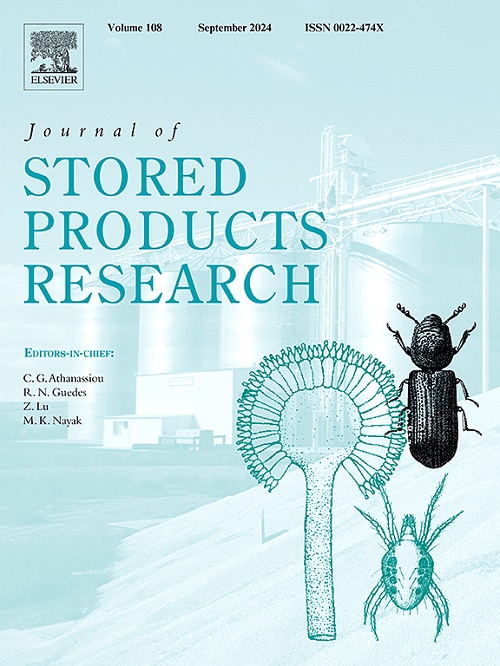不同贮藏条件下玉米籽粒的理化性质、结构分析及CO2浓度
IF 2.7
2区 农林科学
Q1 ENTOMOLOGY
引用次数: 0
摘要
本研究旨在评价贮藏条件(密闭和非密闭)、初始含水量(14%、16%和18% wb)和贮藏时间(0、30、60、90和120 d)对玉米籽粒品质的影响。在贮藏期间,对CO2浓度、温度、相对湿度、近端成分、干物质损失、淀粉和昆虫危害进行了评价。BRS284玉米籽粒在收获和贮藏时,初始含水量分别为18%、16%和14%。在长达120天的时间里,每隔1小时对谷物质量和环境空气中的[CO2]、温度和相对湿度进行监测。结果表明,随着贮藏时间的延长和水分含量的增加,籽粒中的CO2、温度和相对湿度均有所增加。两种条件下干物质损失率均增加,非密闭条件下损失率更大,密闭条件下未发现昆虫。粗脂肪和蛋白质含量随着水分的增加和贮藏时间的延长而降低,淀粉颗粒则随着水分的增加而趋于致密化。本文章由计算机程序翻译,如有差异,请以英文原文为准。

Physicochemical properties, structural analysis and CO2 concentrations of corn grains stored under different conditions
This study aimed to evaluate the effects of storage conditions (hermetic and non-hermetic), initial moisture content (14, 16, and 18 % wb), and storage time (0, 30, 60, 90, and 120 days) on corn grains quality. During the storage period, the concentration of CO2, temperature, relative humidity, proximal composition, dry matter loss, starch, and insect damage were evaluated. The BRS284 corn grains were harvested and stored with an initial moisture content of 18, 16, and 14 % wb. The [CO2], temperature, and relative humidity were monitored by sensors in grain mass and ambient air for up to 120 days, at 1-h intervals. The results indicated increases in [CO2], temperature, and relative humidity in the grain mass, with increased storage time and higher moisture content. The rates of dry matter loss increased for both conditions, more intense for non-hermetic storage, no insect was observed in grains stored hermetically. The ether extract and protein contents decreased with rising moisture content and storage time, while starch granules tended to compact with increasing moisture content.
求助全文
通过发布文献求助,成功后即可免费获取论文全文。
去求助
来源期刊
CiteScore
5.70
自引率
18.50%
发文量
112
审稿时长
45 days
期刊介绍:
The Journal of Stored Products Research provides an international medium for the publication of both reviews and original results from laboratory and field studies on the preservation and safety of stored products, notably food stocks, covering storage-related problems from the producer through the supply chain to the consumer. Stored products are characterised by having relatively low moisture content and include raw and semi-processed foods, animal feedstuffs, and a range of other durable items, including materials such as clothing or museum artefacts.

 求助内容:
求助内容: 应助结果提醒方式:
应助结果提醒方式:


